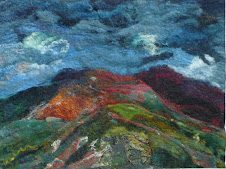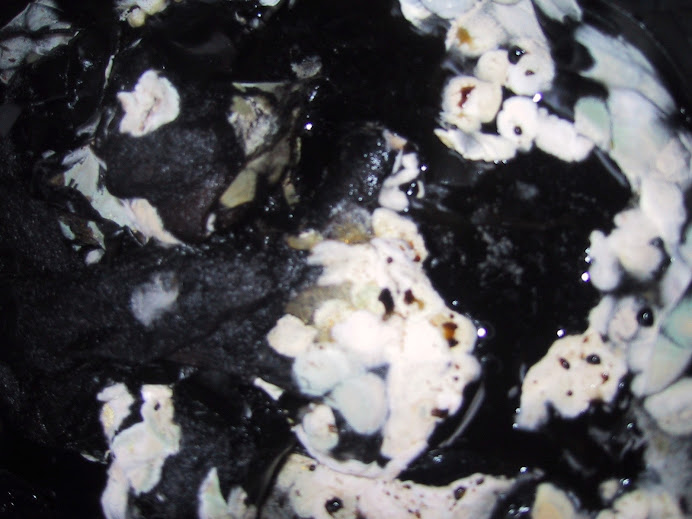Here is Maureen delighted with the colour of her hand spun yarn at the Dyeing the Blues Workshop

Yesterday I held the last of a series of natural dyeing workshops held in the studio here over the summer. This one was Dyeing the Blues and covered dyeing with a variety of sources of indigotin. I decided to roughly follow the path that dyeing the blues would have taken in history. so we started by picking woad ( Isatis Tinctoria) and the Chinese Woad (Isatis indigotica) which turned out to be covered in lots of green caterpillars happily munching away. We tore the leaves up,having removed the caterpillars, and covered with boiling water. After twenty minutes we squeezed out the leaves and added washing soda to the liquid. I put in a bit too much and the pH was 10. My students energetically beat the liquid and the froth turned an astonishing deep deep blue. I had never had this before. Was it the time of the year? The hard beating? Or the unusually high pH , I usually have a pH of 9). Unfortunately I took few photos. I find it difficult to take photos at workshops as I am always racing around keeping everything running smoothly so there were none of this stage. I added thiourea dioxide to reduce the vat
The next vat was an introduction to a fermentation vat. I had a large one with about 9 litres in which was a madder/bran vat started four day ago. This too produced very dark blue fibres nearly a midnight blue. The indigotin in this vat came from Indigofera Tinctoria.
My students then made a stock solution also with indigotin from Indigofera Tinctoria ready to make a modern vat and we went off for lunch.
After lunch we dyed with the woad vat. This gave a deep blue the deepest colour I have ever had from fresh woad leaves. I have included a photo of the increasing depth of colour from repeated dippings from a previous workshop as a pointof comparison . The woad dyed the equivalent of no 10 ( reading from left to right starting at the top left).

Time seemed to vanish and we rushed around dyeing with what I described a Modern Vat or Chemical Reduction vat, before galloping back out into the garden at high speed at about 2.45 to gather Persicaria Tinctoria ( the Japanese Polygonum Tinctoria). We gathered two armfuls of these stripped off the leaves then all five of us chopped away with scissors. I covered the leaves with water and acetic acid and then kneaded the leaves. We strained the leaves and then I kneaded the leaves again just as I would have kneaded bread and added the resulting liquid to the rest in the bucket. We stuffed in silk, and wools and even one hank of tencel before leaving it to go back to more dyeing indoors.  Finally at nearly 4 o clock we found all our fibres in the Persicaria Tinctoria had turned a beautiful turquoise and everyone was pleased and excited (especialy me as this was only the fourth time I had used the fresh leaves to get turquoise with one failure.) Below is a silk cap on the left, handspun tencel yarn ( spun by Maureen) and Teeswater curls on the right.
Finally at nearly 4 o clock we found all our fibres in the Persicaria Tinctoria had turned a beautiful turquoise and everyone was pleased and excited (especialy me as this was only the fourth time I had used the fresh leaves to get turquoise with one failure.) Below is a silk cap on the left, handspun tencel yarn ( spun by Maureen) and Teeswater curls on the right. The photo below shows the bucket after dyeing which today has gone a deep blue with grains of stuff on the bottom which I assume is indigotin settling out.
The photo below shows the bucket after dyeing which today has gone a deep blue with grains of stuff on the bottom which I assume is indigotin settling out.
 Finally at nearly 4 o clock we found all our fibres in the Persicaria Tinctoria had turned a beautiful turquoise and everyone was pleased and excited (especialy me as this was only the fourth time I had used the fresh leaves to get turquoise with one failure.) Below is a silk cap on the left, handspun tencel yarn ( spun by Maureen) and Teeswater curls on the right.
Finally at nearly 4 o clock we found all our fibres in the Persicaria Tinctoria had turned a beautiful turquoise and everyone was pleased and excited (especialy me as this was only the fourth time I had used the fresh leaves to get turquoise with one failure.) Below is a silk cap on the left, handspun tencel yarn ( spun by Maureen) and Teeswater curls on the right. The photo below shows the bucket after dyeing which today has gone a deep blue with grains of stuff on the bottom which I assume is indigotin settling out.
The photo below shows the bucket after dyeing which today has gone a deep blue with grains of stuff on the bottom which I assume is indigotin settling out. 

This photo is of all the colours of day. The bright greens were golderod overdyed with indigotin from the woads
The pan below is the Persicaria Tinctoria vat today.

S






















Very interesting to read about your blue workshop, because that is what I have been dyeing lately, too:) And all the different ways to dye with indigo plants, your students are very lucky to have you as a teacher.
ReplyDeleteI hope somebody has the answer why your woad gave so dark color, very beautiful. My woad is still waiting to be harvested.
By the way, your book and your additional instructions to use japanese indigo were in good use last week:) Thank you.
Thank you Leena. I really enjoyed doing it too. It was so exciting to have all these indigotin bearing plants in the garden although it it will be race between me and the caterpillars as to who gets the last of the Chinese Woad! I have decided to use up all the very last of the woads and have another go and see if I can get that really dark blue again. I am so glad that the book has come in useful too:) always nice to hear!
ReplyDeleteThese blues are so beautiful.
ReplyDeleteI haven't tried indigo or woad dyeing yet as I'm rather put off by the seeming complexity of it all. But if you get colours like these I guess I'm just going to have to give it a go!
Well Sue there is always my book, the Colour of the Sea and Sky the Art of Indigo Dyeing :) available from my website! However Jenny Dean in her book Wild Colour and Natural Dyeing gives the recipe for a very good one step indigo vat using washing soda and colour run remover which are both easy to get. It works very well apart form it being difficult to get really dark shades and I used it for years.
ReplyDeleteAmazing colors, and I am impressed you can do so much in one workshop, I get confused just taking care of my vats for me personally, you are a dye goddess...lol
ReplyDeletethanks ...blushing :)
ReplyDeleteOh Helen. How I would love to be able to take some of your workshops! Eventually I will make my way back around to natural dyeing again :)
ReplyDeletesounds like an amazing workshop. Does your indigo book talk about making all the different types of vat you mention? I want to learn more about alternatives to the modern chemical vat.
ReplyDeleteHi Fiona I talk about every type of vat! In the book there are three fermentation vats,one is the madder bran vat which is one of the traditional fermentation vats and I think one of the easiest to maintain and the other a yeast molasses vat I worked out myself Oh and the third is the stale urine vat. They are so easy to maintain. You need to be able to keep the vat warm as they don't like abrupt changes in temperature. On top of a boiler, in an airing cupboard, back of an aga, on heating pad (which is what I use),or fish tank heater. Once you get the hang of them they are lovely to have and give beautiful beautiful blues
ReplyDelete